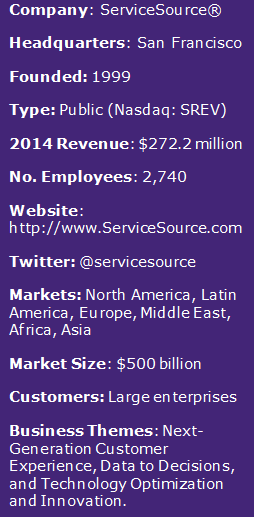I'm in the process of writing profiles of vendors in the customer success management industry. These vendor profiles are a tool for buyers to evaluate their customer success management options before selecting a vendor. In addition to an overview of the vendor, these documents identify key differentiators, product offerings, and provide a short list guide for buyers.
The first vendor I profiled is ServiceSource®. Stay tuned, as more profiles will be published in the weeks to come.
Customer Success Management: ServiceSource® provides B2B companies with technology-enabled services, cloud software and best-practice processes to improve customer success, drive revenue growth and decrease churn from existing customers. It began as a managed services firm and evolved by adding a software platform. ServiceSource had $272.2 million in revenue in 2014.
 What Does ServiceSource Do? ServiceSource’s solutions help companies manage the end-to-end customer revenue lifecycle, including onboarding and adoption, upsell and cross-sell, retention and renewals. With more than 15 years of experience focusing on customer success and revenue growth, ServiceSource has the depth of expertise companies need to manage their revenue lifecycle. With deployments across 40 languages and 150 countries and a recurring revenue technology platform, ServiceSource manages billions of dollars of recurring revenue for clients annually.
What Does ServiceSource Do? ServiceSource’s solutions help companies manage the end-to-end customer revenue lifecycle, including onboarding and adoption, upsell and cross-sell, retention and renewals. With more than 15 years of experience focusing on customer success and revenue growth, ServiceSource has the depth of expertise companies need to manage their revenue lifecycle. With deployments across 40 languages and 150 countries and a recurring revenue technology platform, ServiceSource manages billions of dollars of recurring revenue for clients annually.
Why Customer Success Management Important Today: Today’s cloud businesses have unprecedented visibility and data on customers that can be harnessed with a customer success management platform. This opens up new opportunities and smarter ways to connect and engage with customers to maximize revenue and to determine what customers need and want so they remain loyal and provide high customer lifetime values.
An Overview of Customer Success Management: Before the opt-in economy, many businesses were focused on the initial sale. A great deal of money was spent advertising and marketing to potential prospects, enticing them to convert from a lead to a sale. However, little attention was paid to the after-sale experience and financial longevity of the client, even though poor customer experiences and churn still exist today after decades of research showing that after-sales service directly affects the financial stability of a company. In fact, it never made sense for companies to spend millions, or in some cases, billions of dollars in advertising, marketing and sales to then drive the customer to a competitor when the after-sales service experience is horrible. Yet poor after-sales service occurs every single day in many, many companies.
Before, During and After the Sale: Customer Success Management (CSM) is based on the ability to deliver a consistent customer experience process – before, during, and in particular, after the sale – which results in maximized customer lifetime value and enhanced revenue that leads to increased margins and profits. A shift to CSM happened because we live in a continuous, opt-in economy, where the value of customers is determined by how long they stay customers and if they continue to increase their purchase amounts over time. Because of our opt-in economy, companies must prepare themselves to deliver great, continuous and consistent customer experiences.
This seismic shift to a post-sale, on demand, attention economy transforms the value exchange among customers, partners, suppliers, and brands. And as organizations move to digital business models, CSM plays a critical role in enabling brands and organizations to keep and deliver their brand promise as well as enhance their bottom line.
What’s the Best Option for Your Company? When choosing the best option for CSM software for your organization, the choice will depend on the business goals of CSM initiatives, the degree to which CSM has been integrated into your culture and how well employees have adopted this mindset. It may be that some organizations will be further along the adoption cycle, while others will need internal champions to encourage and enforce the use of customer success software, processes and best practices.
Data to Decisions Drives the Democratization of Insight: The CSM field has been spurred on by the need to provide after-sales service intelligence that can be turned into actionable insights and decisions. Holistic, data-driven decisions require a multi-disciplinary approach that incorporates performance monitoring with traditional business intelligence technologies.
A multitude of data sources can be transformed into information streams guided by business process. As context is applied to information streams, patterns emerge that provide nuggets of insight. That insight then drives the ability to take action and make better decisions. This shift to using insight not only can serve high-margin, “luxury” brands, but also should be considered for all businesses through an investment in CSM. By transforming business models to include processes that immediately turn data into decisions, brands and organizations gain the ability to provide great, loyalty inspiring experiences that reduce churn and increase revenue.
Make sure to stay tuned for the next part of the mutli-part study!
Check out my vendor profile of ServiceSource®. An excerpt of the profile including the table of contents is available to download.
@drnatalie
VP and Principal Analyst, Constellation Research, Covering Customer Success Management, IOT, Analytics and Customer-facing Applications that Deliver Enhanced, Trust-building Customer Experiences via Customer Service, Sales and Marketing



